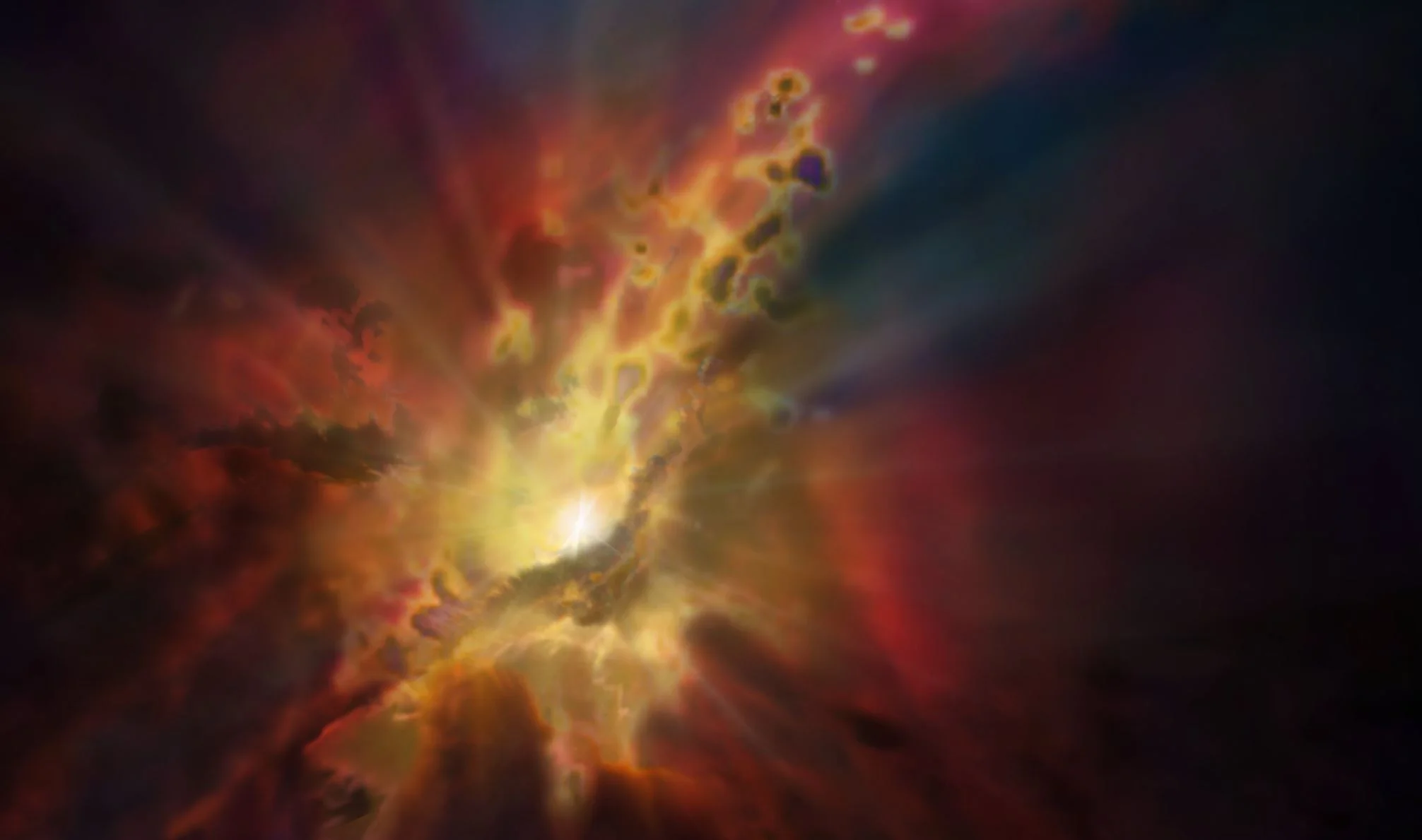Any comments, suggestions or just looking for a chat about this subject? Don't hesitate and leave a comment on our improved comment section down below the article!
By Stephen Hamer - University of Bath
Image Credit: NRAO/AUI/NSF; Dana Berry/SkyWorks; ALMA (ESO/NAOJ/NRAO)
A fountain in a garden pond could shoot a plume of water to roughly three metres in height. By comparison, the famous fountain on Lake Geneva launches a plume of water up to 140m into the air. Now imagine a fountain launched from the centre of a galaxy, with a supermassive black hole acting as the pump. How far do you think this plume would extend? The answer is over 100,000 light years.
We know this as we have just spotted such a fountain – spewing out incredibly cold gas rather than water – in a giant galaxy at the centre of a cluster of galaxies known as Abell 2597. Astronomers have long believed that such fountains must exist in some galaxies – continually circulating fuel that can form stars. Now our findings, published in The Astrophysical Journal, finally prove they do exist in nature.
We were able to view this spectacle in its full glory by combining observations from two of the worlds most powerful telescopes, the Atacama Large Millimetre Array (ALMA) and the Multi Unit Spectroscopic Explorer (MUSE). MUSE showed the gas being pumped out and reaching the top of the plume, while ALMA revealed how it thereafter rained back down into the supermassive black hole (an extremely large black hole), triggering the whole process over again. The power of the event is phenomenal. The fountain is in fact lifting more than 3 billion solar masses of cold gas from its centre.
Galaxy maintenance
Our international team of astronomers chose to look at this particular galaxy, which is located a billion light years away from us, because of its position at the centre of a cluster of galaxies. Such clusters are filled with extremely hot gas at more than 10m degrees, known as the intracluster medium. We know that this hot gas can cool very quickly – and when it does it produces massive amounts of star forming fuel for galaxies at the centre of the cluster, such as this one.
Composite image showing the fountain-like flow of gas - Image Credit: ALMA (ESO/NAOJ/NRAO), Tremblay et al.; NRAO/AUI/NSF, B. Saxton; NASA/Chandra; ESO/VLT via Wikimedia Commons
Left unchecked, this can result in an enormous burst of star formation within the central galaxy, producing up to 1,000 new stars the size of our sun every year. But astronomers typically only measure star formation rates at less than 1% of this in such galaxies . Our discovery finally demonstrates why – it’s the effect of the fountain continually cycling the star forming fuel. This stops the gas forming stars and keeps the galaxy from growing too big too fast.
The process, called mechanical feedback, takes place when the black hole launches “jets” – two streams of plasma (matter made up of electrically charged particles despite having no overall charge), travelling in opposite directions at velocities very close to the speed of light. The jets, which astronomers have known about for some time, inflate enormous bubbles in the surrounding hot gas. As these bubbles rise, they lift the colder gas out of the galaxy, producing the plume of the fountain. But the gas does not move quickly enough to escape the galaxy’s gravity, eventually raining back down onto it.
What was lacking from this picture though, was knowledge about how the jets from the black hole were powered. Some gas had to be falling into the black hole, releasing huge amounts of energy and driving the outbursts. With ALMA we were able to complete the picture, showing that gas clouds at less than 300 light years from the black hole are falling towards it due to its immense gravity. Taken together with the MUSE data, our study is the first compelling evidence for the simultaneous inflow and outflow of gas around a supermassive black hole – representing the full cycle of the fountain.
More fountains?
While we’ve only spotted one fountain, the process is likely to be at play in other similar galaxies at the centre of clusters. We know these galaxies have changed little over the past few billion years, despite the abundance of fuel to potentially form stars. By continually cycling the star forming fuel, galaxy fountains help to keep them so stable.
The process may actually affect all galaxies at some point in their lives. That’s because all galaxies have some cooling gas to fuel such fountains. However galaxies far from the centre of a cluster are likely to have less cooling gas available, so their fountains will be smaller and only shortlived.
Still, given there could be more than 200 billion galaxies in the universe, there are probably a lot of galaxy fountains out there.
Source: The Conversation
If you enjoy our selection of content please consider following Universal-Sci on social media:

















